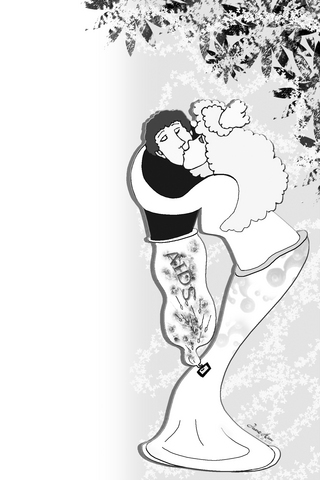It was hailed as the biggest contraceptive revolution since the invention of the Pill. "Johnny's had a sex change," went the publicity strapline, and in the eight months preceding its 1992 launch in the UK it had generated articles in the press and TV and radio features. There was a #1 million advertising campaign, which included a two-week neon-lit display on the famous Spectacolor board in London's Piccadilly Circus, and people queued outside pharmacists to buy it. But 13 years on, UK usage is so low that it registers as 0 percent according the National Office of Statistics' report on Contraception and Sexual Behaviour. How did the British fall so quickly out of love with the female condom?
The answer may be that Britain never really loved it in the first place. The female condom may have seemed a good idea to most modern, emancipated women in 1992 (when the world was was riding the second wave of Aids terror, with heterosexuals the new victims). But once they saw it up close -- and tried using one -- they weren't so keen.
The Femidom (the British brand name for the invention) is a baggy, seven-inch prelubricated polyurethane tube designed to line the vagina. It looks like a cross between a pair of diaphragms and a male condom that might have been used as a water bomb. It can't have helped that the Danish inventor, Dr. Lasse Hessel, originally intended it to be used as an incontinence sheath.

Newspaper headlines such as "Is that an amoeba between your legs?" weren't helpful either. Nor was the British comedian Jo Brand, who couldn't resist such a comic gift: "Like a supermarket carrier bag," she said. "What a nightmare if one of those falls out of your handbag in the pub. What do you say? `It's all right, I'm just off on a ballooning weekend.'" And let's not forget the infamous "rustle," the noise that the Femidom made during sex.
"Fun with a windsock" is how 30-year-old marketing executive Louise Sandler recalls her first and only Femidom experience, in 1993, at university. "They were being given out in the student union.
"My boyfriend was up for it because it meant he wouldn't have to wear a condom. But once was enough; first off, I couldn't get it in. The instructions said, `Squeeze inner ring together and slide to cover cervix.' I mean, what sort of woman has the capacity to slide her entire hand inside herself -- and in front of her boyfriend?"
The manufacturers had calculated that older, sexually confident women in steady relationships would be the initial takers -- and that it would take three trial runs for a woman to feel comfortable with the product. But woman-to-woman endorsement was vital, and when even a balanced and, on the whole, positive feature in Cosmopolitan began: "It's not for an elephant or a donkey, but it is the strangest-looking thing ...," it didn't matter how sensible, safe or comfortable the female condom might be; it was just a bit too weird.
All the more surprising, then, that it is precisely the female condom's shape and modus operandi -- as well as its funny rustle -- that have helped reverse its fortunes. It might not have taken off in Britain, but in at least 80 of the 125 countries outside Britain where the condom is sold, it's huge news.
By the late 1990s, the product was in the hands of an American firm, the Female Health Company (FHC), and business was so bleak that they were on the verge of throwing in the towel. Then Mary Ann Leeper, the firm's president, took the first of two phonecalls that would change everything.
"It was a woman called Anna, from Harlem, New York," recalls Leeper. "She said: `I just called to thank you for doing this. If I asked the man I live with to wear a male condom, he'd beat me up and throw me out. Me and my sisters, we use this and we thank you greatly.'"
The second call came several months later, from a woman called Daisy at the Ministry of Health in Zimbabwe.
"She told me that, on her desk, she had a petition signed by 30,000 women wanting us to bring the female condom to Zimbabwe," says Leeper.
Sniggering at the Femidom, it seemed, was a privilege only for those lucky enough to have a choice about whether or not to sleep with a man who wouldn't wear protection. FHC subsequently struck a deal with the World Heath Organisation to sell the female condom at a discount to education programmes in more than 80 developing countries, mainly those hit hardest by Aids.
Its reception was unprecedented.
"It's very hard to reverse negative preconceptions," says Anne Philpott, who worked for FHC, introducing the female condom into sexual health programmes for three years until last February.
"But in Colombo, Sri Lanka, where I was working with female sex workers, their clients hadn't heard of a female condom before. So there were no preconceptions, and rather than saying, `This is a condom, this is going to protect you,' (the women) marketed it as a sex toy, allowing the client to insert it -- a real thrill, because seeing a vagina up close, or touching one, is a huge taboo in Sri Lanka," she said.
The design held a further unexpected thrill, as the plastic ring inside rubs against the tip of the penis during intercourse, intensifying the man's orgasm. Subsequently, the prostitutes started charging more for sex with a female condom. Suddenly, FHC had tapped into a whole new approach to marketing.
In Senegal, the condoms are sold with noisy "bine bine" beads; an erotic accessory that women wear around their hips. The rustle of the polyurethane during sex is now associated with the clicking of the beads -- and so, a turn-on. Senegalese women have also cleverly suggested that the large size of the condom reflects that of their partner's penis.
In Zimbabwe, where 930,000 of the 1,600,000 adults infected with HIV are women, a new word -- kaytec-yenza -- has entered the vernacular to describe the "tickle" created by the inner ring rubbing against the penis. Women too are gaining extra pleasure from the condom.
"In India," Philpott says, "women told me they had become so excited inserting the condom that they didn't want to have sex. I couldn't work it out -- were they doing it wrong, hurting themselves? Then I realised they'd been having orgasms just from putting the condom in."
"Probably because they'd never touched themselves before," Philpott says.
In the developing world, the Female Health Company's strategy is to raise the quantity of female condoms sold from 10 million to around 200 million -- staggering when you consider that 6 to 9 billion male condoms were bought and distributed last year in the developing world. As for the rest of the world, the issue now is money, says Leeper, and FHC is looking for a commercial partner "committed to reproductive health," she says.
Encouragingly, a pilot remarketing campaign in Austin, Texas, was a huge success. After a three-month educational programme backed by sexy, youth-friendly adverts in magazines such as Rolling Stone, "You couldn't keep it on the shelves," says Leeper. "It sustained itself for three years -- but we don't have the cash to maintain that kind of push."
In the meantime, a bit of guerrilla marketing is going on behind the scenes. Philpott is hoping to replicate some of the success she has seen abroad over here. She has set up a company, the Pleasure Project, to build a bridge between sexual enjoyment and sexual health.
One of her recent jobs was as a consultant on a British-made safer sex erotic film called Modern Loving, directing the real-life couples on set to make the Femidom sexy (her Indian anecdote inspired a solo fantasy scene). With women accounting for 47 percent of all people living with HIV globally, and British teenage pregnancy and STD rates soaring, it would be nice to think that the western world might take inspiration from the men of Sri Lanka, and instead of an amoeba, start seeing in the female condom "a beautiful, blooming lotus flower." But that could take some time.

As strategic tensions escalate across the vast Indo-Pacific region, Taiwan has emerged as more than a potential flashpoint. It is the fulcrum upon which the credibility of the evolving American-led strategy of integrated deterrence now rests. How the US and regional powers like Japan respond to Taiwan’s defense, and how credible the deterrent against Chinese aggression proves to be, will profoundly shape the Indo-Pacific security architecture for years to come. A successful defense of Taiwan through strengthened deterrence in the Indo-Pacific would enhance the credibility of the US-led alliance system and underpin America’s global preeminence, while a failure of integrated deterrence would
The Executive Yuan recently revised a page of its Web site on ethnic groups in Taiwan, replacing the term “Han” (漢族) with “the rest of the population.” The page, which was updated on March 24, describes the composition of Taiwan’s registered households as indigenous (2.5 percent), foreign origin (1.2 percent) and the rest of the population (96.2 percent). The change was picked up by a social media user and amplified by local media, sparking heated discussion over the weekend. The pan-blue and pro-China camp called it a politically motivated desinicization attempt to obscure the Han Chinese ethnicity of most Taiwanese.
On Wednesday last week, the Rossiyskaya Gazeta published an article by Chinese President Xi Jinping (習近平) asserting the People’s Republic of China’s (PRC) territorial claim over Taiwan effective 1945, predicated upon instruments such as the 1943 Cairo Declaration and the 1945 Potsdam Proclamation. The article further contended that this de jure and de facto status was subsequently reaffirmed by UN General Assembly Resolution 2758 of 1971. The Ministry of Foreign Affairs promptly issued a statement categorically repudiating these assertions. In addition to the reasons put forward by the ministry, I believe that China’s assertions are open to questions in international
The Legislative Yuan passed an amendment on Friday last week to add four national holidays and make Workers’ Day a national holiday for all sectors — a move referred to as “four plus one.” The Chinese Nationalist Party (KMT) and the Taiwan People’s Party (TPP), who used their combined legislative majority to push the bill through its third reading, claim the holidays were chosen based on their inherent significance and social relevance. However, in passing the amendment, they have stuck to the traditional mindset of taking a holiday just for the sake of it, failing to make good use of